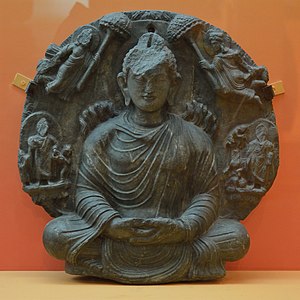The Twin Miracle

The Twin Miracle, also called the Miracle at Savatthi (
The Miracle at Kapilavastu
According to Buddhist texts, when the Buddha returned to his home kingdom of
The Miracle at Savatthi
Background
According to the Pali version of the story, in the Buddha's time, a wealthy treasurer suspended a sandalwood bowl in the air with a cord, hoping to find an enlightened being who can fly up and take it. For six days, teachers from six other religious sects attempted to trick the treasurer into giving them the bowl, but failed. On the seventh day, news of this reached one of the Buddha's disciples, Pindola Bharadvaja, who then proceeded to fly up and take the bowl, thus converting the treasurer to Buddhism. While on his way back to the monastery, he was asked by people who missed the miracle to perform it again, which he did.[11]
When the Buddha hears about this, he reprimands Pindola for doing this, and lays down a rule forbidding monks from using supranormal powers for such purposes.[11] Upon hearing that the Buddha laid down a rule forbidding his monks from showing off miracles, six jealous teachers from rival religious sects try to win back followers by publicly challenging the Buddha to a miracle tournament, thinking he would refuse to perform one.[1][5] In the Sanskrit account of the event, the sandalwood bowl story is absent and the six jealous teachers, confident in their own supranormal powers, challenge the Buddha to a miracle contest on their own accord in hopes of regaining followers.[1]
The Miracle Tournament

According to the
The Buddha declares that he will perform the miracle at the foot of a mango tree in
The Buddha starts by creating a jeweled walkway in midair and prepares to perform the miracle for the crowd of observers, but is interrupted by several of his disciples, who ask to perform a miracle in his place to save him the trouble.
At the conclusion of the miracle, it is the rival religious leaders' turn to perform a miracle but they are unable to move. A strong wind knocks down the pavilion they prepared for the tournament and the rival teachers flee, with one committing suicide.[18] The Buddha continues the miracle and proceeds to create a single duplicate of himself and then have the duplicate ask him questions which he would in turn answer in order to teach the observing audience.[18][17]
Following the miracle, the Buddha is said to have ascended to
| The Miracle at Sravasti |
|
References
- ^ )
- ^ ISBN 9788120831391.
- ^ ISBN 9781134242030. Archivedfrom the original on 2021-03-18. Retrieved 2019-05-09.
- ISBN 9788120610712. Archivedfrom the original on 2018-03-27. Retrieved 2019-05-12.
- ^ ISBN 9789004279391. Archivedfrom the original on 2021-03-18. Retrieved 2017-09-12.
- ISBN 9781681721118. Archivedfrom the original on 2022-05-06. Retrieved 2019-06-15.
- ISBN 9789559098423. Archivedfrom the original on 2021-08-18. Retrieved 2021-12-05.
- )
- ISBN 9781681721118. Archivedfrom the original on 2022-05-06. Retrieved 2019-06-15.
- ISBN 9789559098423. Archivedfrom the original on 2021-08-18. Retrieved 2021-12-05.
- ^ ISBN 9788120820722. Archivedfrom the original on 2021-03-18. Retrieved 2019-05-09.
- )
- ISBN 9788120820722. Archivedfrom the original on 2021-03-18. Retrieved 2019-05-09.
- )
- )
- ^ ISBN 9788120820722. Archivedfrom the original on 2021-03-18. Retrieved 2019-05-09.
- ^ ISBN 9788120820722. Archivedfrom the original on 2021-03-18. Retrieved 2019-05-09.
- ^ )
- )
- ISBN 9788120820722. Archivedfrom the original on 2021-03-18. Retrieved 2019-05-09.
Further reading
- Brown, Robert L. (1984). The Śrāvastī Miracles in the Art of India and Dvāravatī, Archives of Asian Art 37, 79-95
- Foucher, Alfred (1914). The Great Miracle at Sravasti in the Beginnings of Buddhist Art, Paris: P. Geuthner, pp. 147-284.





